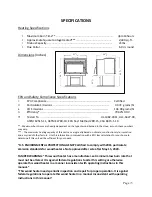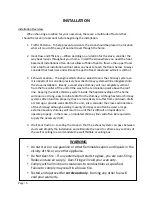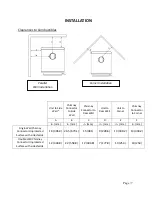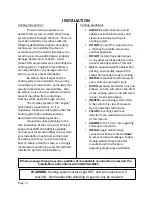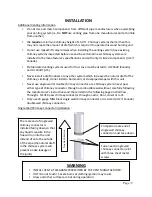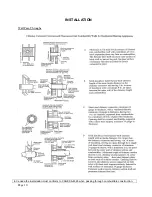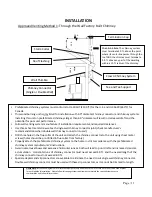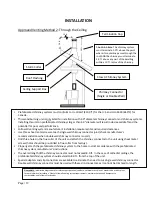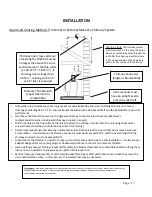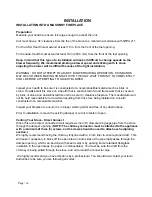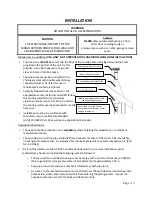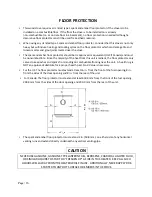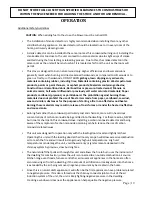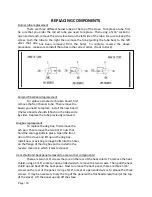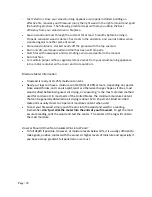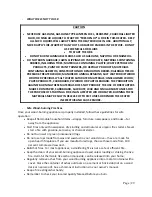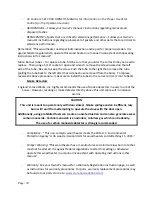
Page | 19
OPERATION
Additional
Safety
Guidelines
CAUTION:
When
adding
fuel
to
the
stove,
the
blower
must
be
turned
OFF.
•
The
installation
of
smoke
detectors
is
highly
recommended
when
installing
this
or
any
other
solid
fuel
burning
appliance.
Smoke
detectors
should
be
located
near
or
in
every
room
of
the
home,
particularly
sleeping
rooms.
•
A
smoke
detector
can
be
installed
in
the
same
room
as
this
cordwood
burning
unit;
installing
the
smoke
detector
too
close
to
the
unit
can
lead
to
nuisance
alarms
due
to
slight
wisps
of
smoke
emitted
during
the
fire
starting
or
reloading
process.
Due
to
this,
the
smoke
detector
in
the
same
room
as
the
unit
will
be
most
useful
if
it
is
located
as
far
from
the
unit
as
the
room
will
permit.
•
This
stove
is
designed
to
burn
natural
wood
only.
Higher
efficiencies
and
lower
emissions
generally
result
when
burning
air
dried,
seasoned
hardwoods,
as
compared
to
soft
woods
or
to
green
or
freshly
‐
cut
hardwoods.
DO
NOT
BURN
garbage,
lawn
clippings
or
yard
waste,
materials
containing
rubber,
including
tires;
Materials
containing
plastic:
Waster
petroleum
products,
paints
or
paint
thinners,
or
asphalt
products;
Materials
containing
asbestos;
Construction
or
demolition
debris;
Railroad
ties
or
pressure
‐
treated
wood;
Manure
or
animal
remains;
Salt
water
driftwood
or
previously
salt
water
saturated
materials;
Paper
products,
cardboard,
plywood,
or
particleboard.
The
prohibition
against
burning
these
materials
does
not
prohibit
the
use
of
fire
starters
made
from
paper,
cardboard,
saw
dust,
wax
and
similar
substances
for
the
purpose
of
starting
a
fire
in
an
affected
wood
heater.
Burning
these
materials
may
result
in
release
of
toxic
fumes
or
render
the
heater
ineffective
and
cause
smoke.
•
Burning
fuels
other
than
cordwood,
particularly
coal
and
charcoal,
can
result
in
hazardous
concentrations
of
carbon
monoxide
being
emitted
into
the
dwelling.
For
these
reasons,
NEVER
burn
coal
or
charcoal
in
this
cordwood
stove.
Installing
a
carbon
monoxide
detector
and
being
aware
of
the
symptoms
of
carbon
monoxide
poisoning
can
help
reduce
the
risk
of
carbon
monoxide
related
issues.
•
This
unit
was
designed
for
operation
only
with
the
loading
door
closed
and
tightly
latched.
Operating
this
unit
with
the
loading
door
latched
loosely
or
open
will
allow
excessive
combustion
air
to
reach
the
fire
and
will
result
in
dangerously
high
unit
temperatures.
High
unit
temperatures
can
damage
the
unit,
void
the
warranty
or
ignite
creosote
deposited
in
the
chimney
system
by
previous,
slow
burning
fires.
•
The
natural
draft
that
pulls
air
through
this
unit
and
allows
the
fire
to
burn
uses
the
indoor
air
of
the
dwelling
for
combustion,
unless
the
unit
is
connected
to
an
outside
combustion
air
source.
Kitchen
range
vent
hoods,
furnaces
and
other
air
movement
appliances
in
the
home
are
often
also
removing
air
from
the
dwelling;
if
the
amount
of
air
filtration
or
leakage
back
into
the
home
is
exceeded
by
the
air
being
removed,
negative
pressure
may
be
created
in
the
home.
•
Since
this
is
a
natural
draft
appliance,
it
will
often
be
the
first
appliance
to
have
problems
related
to
negative
pressure.
If
smoke
is
forced
out
the
chimney
connector
joints
or
out
of
the
air
induction
system
of
the
unit,
the
unit
is
likely
fighting
negative
pressure
in
the
dwelling.
Cracking
a
window
or
door
near
the
appliance
can
help
equalize
the
negative
pressure;
DO
NOT
STORE
FUEL
CLOSER
THAN
SPECIFIED
CLEARANCES
TO
COMBUSTIBLES
OR
WITHIN
THE
SPACE
NEEDED
FOR LOADING
THE
STOVE AND FOR
ASH
REMOVAL.

